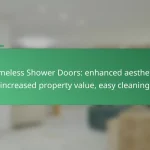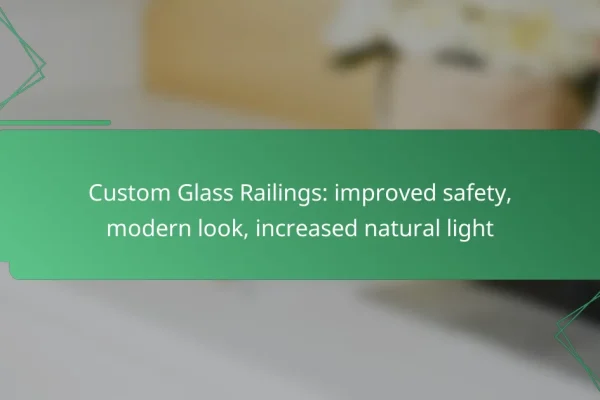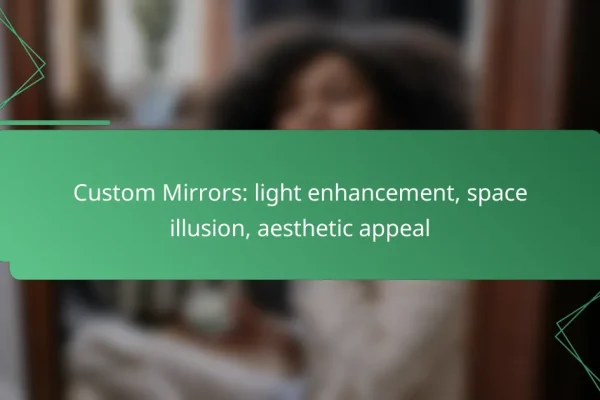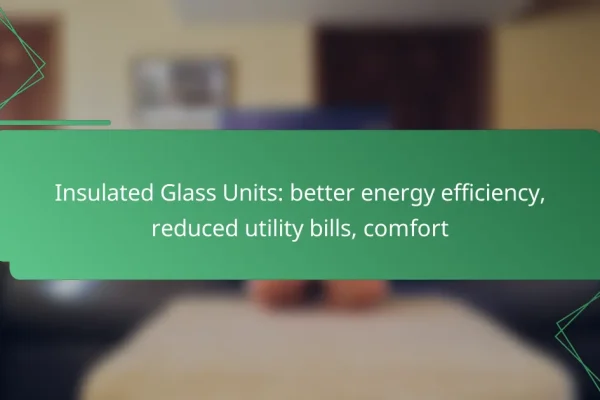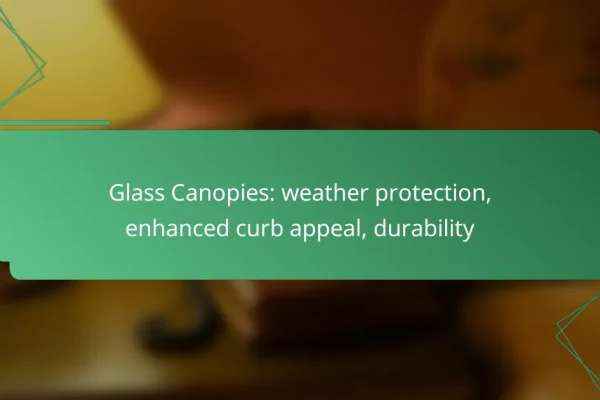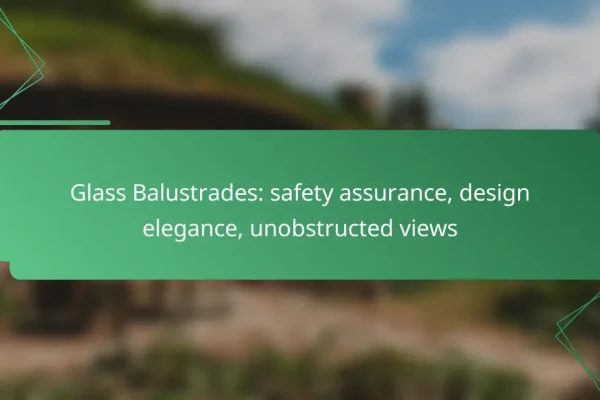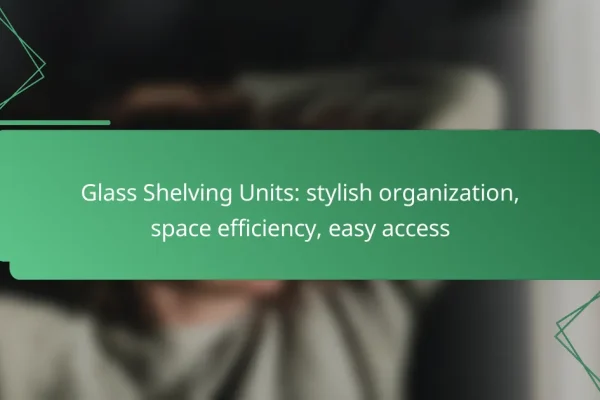What are the benefits of using quality glass solutions in Canada?
Using quality glass solutions in Canada offers significant advantages, including enhanced energy efficiency, improved aesthetic appeal, and increased property value. These benefits stem from the superior materials and technologies employed in quality glass products, which can meet local climate demands and design preferences.
Enhanced energy efficiency
Quality glass solutions contribute to enhanced energy efficiency by minimizing heat loss during colder months and reducing heat gain in warmer seasons. This is particularly crucial in Canada, where extreme temperatures can lead to high energy bills.
Consider using double or triple-glazed windows, which can improve insulation by up to 50% compared to single-pane options. Look for products that meet Energy Star ratings to ensure optimal performance.
Improved aesthetic appeal
Investing in quality glass solutions can significantly enhance the aesthetic appeal of a property. High-quality glass provides clarity and brilliance, allowing for better natural light and unobstructed views.
Architectural glass options, such as low-iron glass or decorative patterns, can elevate the design of both residential and commercial spaces. This not only makes a property more inviting but can also reflect the owner’s style and taste.
Increased property value
Quality glass solutions can lead to increased property value by enhancing both functionality and appearance. Homes and buildings with modern, energy-efficient glass are often more attractive to potential buyers.
In Canada, properties featuring high-performance glass can command higher market prices, as buyers are increasingly looking for energy efficiency and aesthetic quality. Upgrading to quality glass can be a smart investment that pays off in the long run.
How do quality glass solutions improve safety?
Quality glass solutions enhance safety by providing durability and resistance to various hazards. These solutions are designed to minimize risks associated with breakage and exposure to harmful elements.
Shatter-resistant options
Shatter-resistant glass is engineered to withstand impacts without breaking into sharp shards, reducing the risk of injury. Common types include tempered glass and laminated glass, which are often used in high-traffic areas and buildings where safety is a priority.
When selecting shatter-resistant options, consider the specific application and local building codes. For example, tempered glass is typically required in shower doors and glass railings, while laminated glass is ideal for windows in schools and hospitals.
UV protection features
Quality glass solutions can include UV protection features that block harmful ultraviolet rays, which can cause skin damage and fade furnishings. This is particularly important in areas with high sun exposure, such as homes with large windows or commercial spaces.
Look for glass products with a UV filtering rating of at least 99% to ensure effective protection. Additionally, consider using window films or coatings that enhance UV resistance, especially in regions with intense sunlight.
What types of quality glass solutions are available?
Quality glass solutions include various types designed for specific applications and benefits. The most common types are tempered glass, laminated glass, and insulated glass units, each offering unique properties suited for different needs.
Tempered glass
Tempered glass is heat-treated to increase its strength compared to standard glass. This process makes it less likely to shatter upon impact, which is crucial for safety in applications like shower doors and glass railings.
When selecting tempered glass, consider its thickness and the specific safety standards it meets, such as ANSI Z97.1 in the United States. It is typically available in thicknesses ranging from 4 mm to 19 mm, depending on the application.
Laminated glass
Laminated glass consists of two or more layers of glass bonded together with an interlayer, usually made of polyvinyl butyral (PVB). This construction enhances safety by holding shattered pieces together, making it ideal for windshields and storefronts.
When choosing laminated glass, assess the thickness of the glass and the interlayer, as these factors influence sound insulation and UV protection. Common thicknesses range from 6 mm to 12 mm, providing various levels of security and acoustic performance.
Insulated glass units
Insulated glass units (IGUs) are composed of two or more glass panes separated by a spacer and sealed to create an air or gas-filled space. This design improves energy efficiency by reducing heat transfer, making them popular in residential and commercial buildings.
When considering IGUs, check the U-factor and Solar Heat Gain Coefficient (SHGC) ratings, which indicate energy performance. Typical IGUs can achieve U-factors as low as 0.20, significantly enhancing insulation compared to single-pane glass.
How to choose the right quality glass solution?
Choosing the right quality glass solution involves assessing your specific needs, including climate, energy efficiency, and design compatibility. Understanding these factors will help you select glass that enhances performance and aesthetics for your project.
Consider climate factors
Climate plays a crucial role in selecting glass solutions. For instance, in regions with high UV exposure, low-emissivity (Low-E) glass can reduce heat gain while blocking harmful rays. Conversely, in colder climates, double or triple glazing can provide better insulation.
Additionally, consider the local weather patterns. If your area experiences heavy rainfall or snow, ensure that the glass is durable and can withstand such conditions without compromising safety or performance.
Evaluate energy ratings
Energy ratings are essential when choosing glass solutions, as they indicate how well the glass retains heat and reduces energy costs. Look for products that meet or exceed local energy efficiency standards, such as ENERGY STAR ratings in the United States or similar certifications in Europe.
For example, glass with a U-value of less than 1.0 W/m²K is generally considered energy-efficient. This rating helps you gauge potential savings on heating and cooling bills over time.
Assess design compatibility
Design compatibility ensures that the glass solution fits seamlessly with your architectural style and functional requirements. Consider the thickness, color, and finish of the glass to match the overall aesthetic of your building.
Additionally, think about how the glass will interact with other materials used in your project. For instance, if you are using wooden frames, ensure that the glass complements the wood’s natural tones and textures to create a cohesive look.
What are the costs associated with quality glass solutions?
The costs associated with quality glass solutions can vary significantly based on factors such as installation, materials, and ongoing maintenance. Understanding these costs helps in making informed decisions for projects involving glass installations.
Installation costs
Installation costs for quality glass solutions can range from moderate to high, depending on the complexity of the project. For example, standard window installations may cost between $200 and $600 per window, while custom glass features, like shower enclosures or glass railings, can exceed $1,000.
It’s essential to consider the labor involved, which can vary based on local rates and the expertise required. Hiring a professional installer is often recommended to ensure safety and compliance with building codes.
Material costs
Material costs for quality glass solutions depend on the type of glass chosen, such as tempered, laminated, or insulated glass. Prices can range from $10 to $50 per square foot for standard glass, while specialty glass types may cost significantly more.
When budgeting for materials, consider additional factors like framing and finishing options, which can add to the overall expense. Choosing energy-efficient glass can also lead to long-term savings on energy bills.
Maintenance expenses
Maintenance expenses for glass solutions typically involve cleaning and occasional repairs. Regular cleaning can be done with standard glass cleaners, but specialized coatings may require specific maintenance products, which can add to costs.
In terms of repairs, minor chips or cracks can often be fixed for a few hundred dollars, while complete replacements can be much more expensive. It’s advisable to budget for potential maintenance to keep glass installations in optimal condition.
What are common applications of quality glass solutions in Canada?
Quality glass solutions in Canada are widely used in various sectors, including residential, commercial, and industrial applications. These solutions enhance aesthetics, energy efficiency, and safety in buildings and structures.
Residential windows
Residential windows made from quality glass solutions provide improved insulation and energy efficiency, which is crucial in Canada’s varying climate. Double or triple glazing is common, helping to reduce heating costs during cold winters and cooling costs in warmer months.
When selecting residential windows, consider factors such as the window frame material, glass type, and energy ratings. Low-E (low emissivity) glass is particularly beneficial, reflecting heat back into the home while allowing natural light to enter.
Homeowners should also be aware of local building codes and energy efficiency standards when installing new windows. Proper installation is key to maximizing performance, so hiring qualified professionals is advisable to avoid common pitfalls like air leaks or condensation issues.





